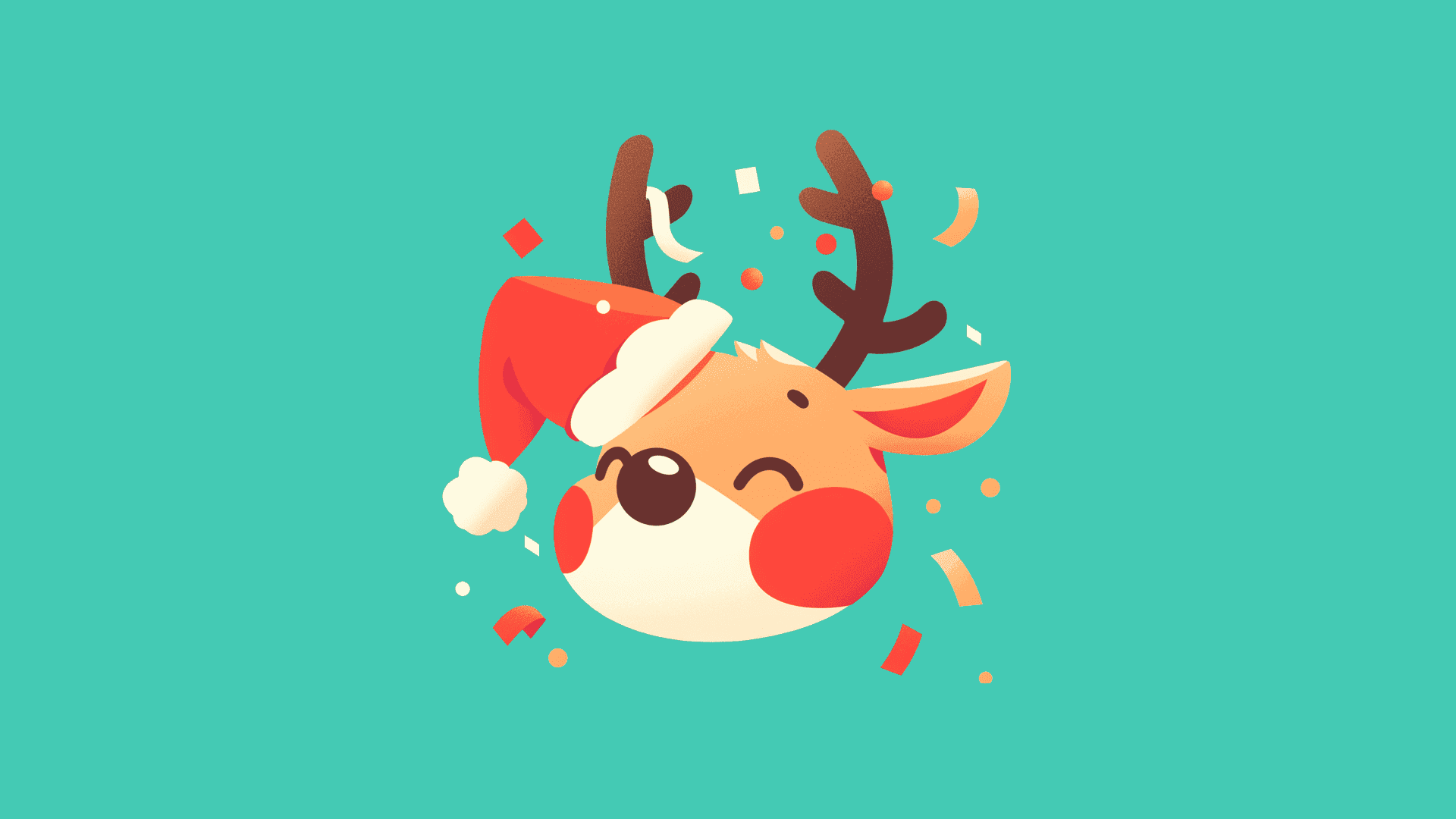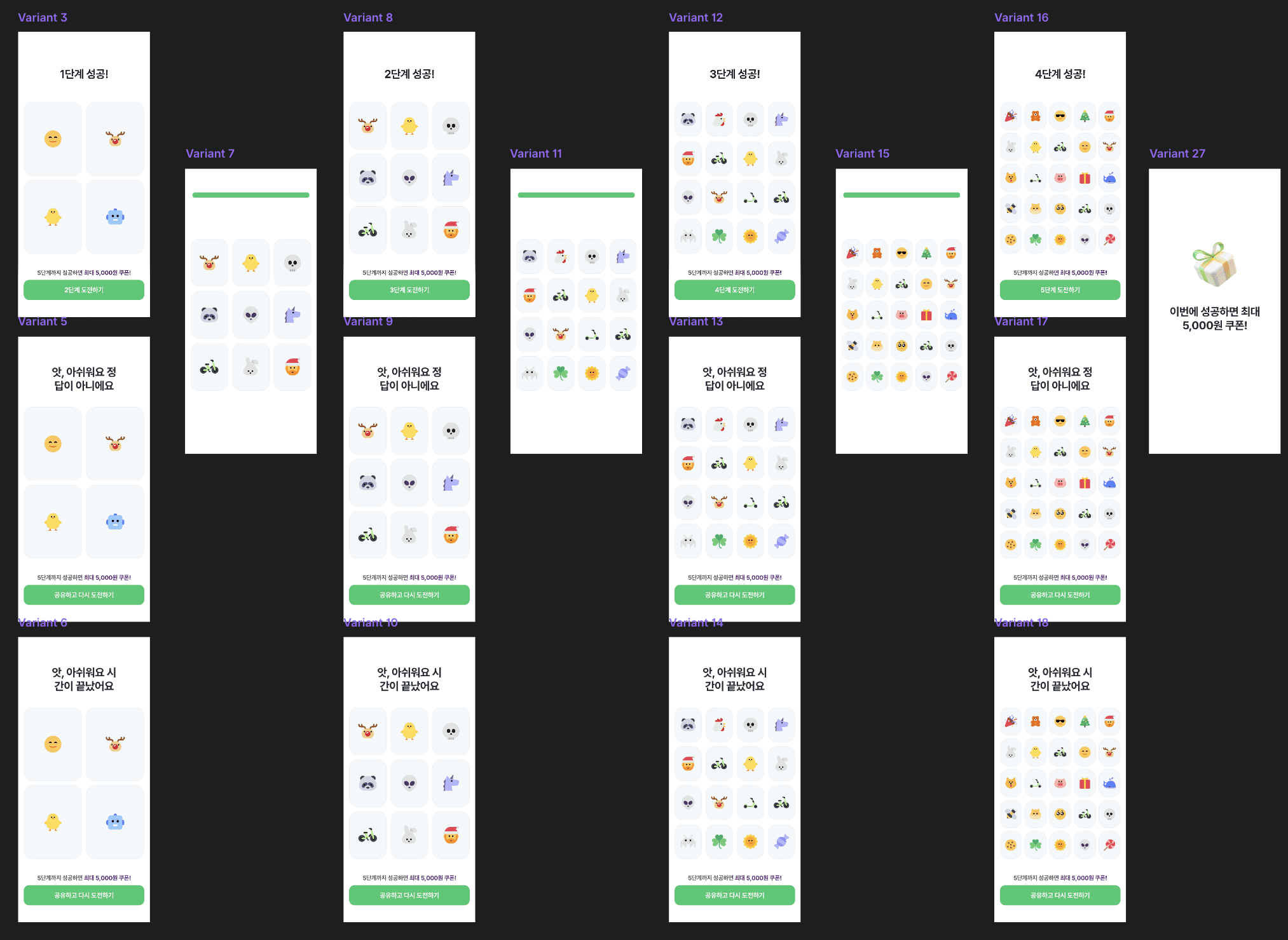
The Idea of "Everyone's Christmas" Emerged from Mid-Summer in Boracay
On December 25 last year, I was walking along the beach in Boracay, feeling the intensely warm air.
While I used to think a "White Christmas" was a given in the winter, people here were singing carols and having fun with Rudolph dolls, laughing and enjoying.
I was slightly shocked, thinking, "Can they really celebrate Christmas in such heat?", but soon this thought came to me.
"It's not limited to cold winters or religion,
anyone can enjoy it as a 'festival.'"
At first, I found it strange, but at the same time, my heart was moved by their enthusiasm.
"How can they all laugh and play without prejudice like this?"
The fresh impression I received that day did not leave my mind even after returning to Korea.
Until now, our company's Christmas event was all about handing out "discount coupons,"
but I started wondering, "What if we made users actively participate and get immersed?"
Ultimately, all that thinking led to the answer of Gamification.
Instead of it ending with a "just getting a discount," what if people could "participate, have fun, and create their own festival?"
I decided to bring that "everyone having a great time" vibe from Boracay
into our Christmas event.

Sandcastle taken in Boracay
Why is Gamification so Popular?
Simply saying "Here’s a coupon!" without any special setting often ends quickly after a brief "Thank you."
But nowadays, many IT and FinTech companies, along with numerous startups, are adding gamification to their events or services.
That's because it's the most intuitive way for users to engage themselves, boast to friends, and naturally increase brand favorability.
1) Engagement (Flow) & Duration
“It feels like I can just go a bit further...”
Gamification uses the Zone of Proximal Development (ZPD) to create a structure that gradually increases in difficulty.
Users find themselves thinking, "Can I clear this if I focus a little more with my skills?", and continue to stay in the game (or event).
Thus, the duration is significantly extended compared to usual events, deepening the bond between users and the service.
2) Virality (Sharing)
“Whoops, missed it. But I can retry by sending a link to a friend?”
Instead of ending in failure, providing a second chance with the Scaffolding technique allows users to spread the event, rather than giving up.
As a result, companies benefit from users promoting through SNS or messengers without additional advertising costs.
This structure of connecting sharing with retries naturally is another major allure of gamification.
3) Data-Driven UX Improvement
“In simple coupon events, only ‘how many used it’ information is gathered...”
Whereas in game-type events, you can collect much more detailed data like stage-wise dropout rates, share frequencies, retry points, etc.
For instance, if dropout rates spike at Stage 2, you can quickly assume "Is it too difficult?" and make adjustments.
Accumulating quantitative indicators like this and improving quickly through Lean UX is another merit of gamification.
4) Brand Favorability & Differentiation
A feeling of “It was fun, so I kept doing it!”
Some users might feel “This game really develops persistence” more than just enjoying coupons and stay longer, boasting to friends.
In the end, it leaves a long-lasting brand image with users thinking, “This event feels different!” even after it's over.
If only discounts were given, it might end at “Thanks,” but by integrating gamification, it’s remembered with “That was really fun!”, naturally differentiating itself.
In summary, gamification induces “I want to try and break it myself” motivation, rather than just deciding on “Shall I get a discount or not.”
It draws engagement through the game, leads to sharing in the process,
and furthermore, allows continuous upgrade through UX data accumulation in the event.
And this entire journey helps naturally build affinity between users and the brand.
Isn't this the main reason why companies are so enthusiastic about gamification nowadays?
Christmas Gamification Completed in 4 Days with Framer
After realizing that “Christmas is a festival for everyone” at the Boracay beach,
we set a seemingly reckless goal.
“Sure, Christmas is just around the corner,
but let’s craft a gamified game in just 4 days!”
The schedule itself was nerve-wracking to merely think about,
but with Framer, we judged we could handle planning, design, and UX development simultaneously.
The collaborative effort divided by days below turned into a success factor.
Day 1: Establish Plan
Starting difficulty at (2×2) expanding to (3×3), (4×4) — a structure “easy then growing harder”
Failure → Retry logic:
“Oh, you were close. Share a link with a friend for another try!”
Scaffolding idea to capture both virality and retry at once
Final reward structure:
Choose one of three boxes upon clearing Stage 5 → Random issuance of country-specific coupons (Korea/USA/Thailand)
Maintain fun till the end with “What coupon will I get?” dopamine effect
After setting this skeleton, the following steps became much easier.
Day 2: Teamwork with Design Team, Framer Framework Setup
Consultation with design team for app main and splash
Suggested to dramatically shift from the existing ‘Santa’ idea to a “Rudolph” theme
First confirmed the splash resonating with Rudolph icon and Christmas atmosphere
Framework construction with Framer
Divide into sections by stages of 2×2, 3×3, and 4×4
Setup basic UI like the main screen (Rudolph logo + “Start” button)
There was a slight worry “Will this even get done in 4 days?” at this point, but we took the plunge.

Framer-created Gamification Flow
Day 3: Implementation of Interactions (Confetti·Shake), Backend Integration
Confetti & Shake Animation
Bursting Confetti upon success at Stage 5 for a fanfare effect
Slight Shake for intuitive feedback “Oops, it’s wrong!” upon failure (gently to avoid irritation)
Cloudflare Worker + Node.js + DB
Handles coupon issuance logic (country-specific filtering, duplicate check) and retry logic (“Share link for another attempt”) on the backend
Multilingual setup (Korean, English, Thai) based on the plan established on Day 2 tied to actual API connections
This day struggled with “minor adjustments of animations.”
If the Confetti burst too much, it obscured the screen, too little, lacked impact…
Also had multiple tests on Shake intensity as overly intense shakes could offend users.
Day 4: QA & Distribution Right Before Christmas
QA (Multilanguage, Performance, Onboarding Flow Inspection)
Carefully checked whether Korean, English, Thai were untangled, initial onboarding phrased naturally, and time limits weren’t excessive
Distributed right before Christmas
“Though it reached some level of completion, can this really work in 4 days?” was the tension
But upon opening, people flooded in with reactions like “Wow, surprisingly fun.”
Thus, even with a brief 4-day schedule,
planning (difficulty, reward, retry) → design (Rudolph theme, visual setup) → development (Framer, Confetti, coupon logic)
interlocked well enough to achieve this,
realizing “This is the power of gamification!” in the moment.
Finished Gamification with Framer
“Not Santa, but Rudolph?” Influence Changed by Design Team Proposal
Originally, it was a simple plan like “Santa dropped presents.”
Further thought “Of course Santa should be the main character for Christmas, isn’t it?”
However, one day, Jamie from the design team suggested this.
“We’ve got the app icon and splash set with a Rudolph concept,
what if Rudolph was forefront instead of Santa?”
I was initially surprised thinking “Abandoning Santa?” but the more I looked at the splash drafts, the more I was drawn.
While Santa is both familiar and good, Rudolph is unexpectedly cuter and visually impactful.
The moment was felt more fun with ‘finding Rudolph’ rather than ‘searching for Santa!’
Ultimately, the story changed to “Rudolph drops presents,”
and users indeed preferred “Funny and relatable Rudolph over Santa.”
What’s important here is it wasn’t just one suggestion from the design team flipping the flow,
but a collaborative effort of planning and design contemplating “how to make characters cuter and charming to capture users’ hearts.”
It was indeed just a change from Santa dropping presents to Rudolph dropping presents,
leading to brighter and lighter user responses.
In essence, it showed that an intro motion could completely reshape the story, elevating overall user experience in an enjoyable manner.
Design team's small suggestion,
eventually led to a more captivating character concept,
injecting new vitality into the entire service.
Santa & Rudolph 1st and 2nd Concepts Made by AI in UX Part (Slight sense of dissonance as AI-generated)
Finished Rudolph by Design Team with Lottie
Core Structure of Rudolph Game
1) Stage Difficulty: (2×2) → (3×3) → (4×4)
Initially, with (2×2) giving a “Huh? This is too easy” vibe, anyone could quickly clear the first stage.
As you progress further, the grid increases to (3×3), (4×4), rapidly decreasing the time limit.
Especially Stage 5 (4×4 + 1~2 seconds limit) presents an impossibly challenging difficulty, but success delivers a burst of Confetti offering electrifying satisfaction of “Oh, I did it!”
UX Points
Initially reduce cognitive load for a sense of “Oh, I can do this!”
As it progresses further, slightly exceed the ZPD to make users feel “I seem to only need a bit more.”
In the end, making it extremely difficult to trigger more of a competitive spirit rather than just a discount, drawing deeper engagement.
2) Retry by 'Sharing with Friends' upon Failure
During the game, feeling “I narrowly missed it!”, rather than ending outright, a prompt displaying “Share link with a friend for another try” appears.
From the user’s perspective, instead of giving up, they can choose to share if they “failed and wished to try again.”
From the operation’s perspective, it creates natural virality through SNS/Messengers without additional advertising.
UX Points
Scaffolding technique provides a second chance, making failure an opportunity for “One more try!” instead of a simple elimination.
People choose to inform others because of “I might win if I tried a little harder…” anticipation,
resulting in a flood of events spreading out through sharing in that process.
3) Final Reward: 3 Boxes & Country-Specific Coupons
Clearing Stage 5 barely, users pick a box from three choices to randomly receive a coupon.
With varying coupon amounts, it keeps dopamine stimulated with “What will I pick?” curiosity.
Conversations and curiosity build up as users compare “My friend got a 2,000 won coupon? I got a 5,000 won one?”.
UX Points
Random rewards incite expectations like “Could I pick something good?” maintaining constant engagement.
Instead of providing a coupon code at once, offering a choice “Which box to open” increases fun and intrigue.
These three aspects (stage difficulty, failure to friend sharing, random box reward) together
transform “I came to collect a discount coupon” into “I’m determined to clear this!”
and create a gamified game where users and the company win.
Every time users retry, they naturally promote and share, which benefits both sides.
80,000 People Engaged in the 4-Day Christmas Event, Exceeding Expectations
Despite only running for 4 days,
approximately 80,000 people (originally expected around 20,000) participated in this event.
The average duration was over 2 minutes, significantly higher when compared to ordinary events.
Among them, there were over 100 ‘heavy users’ retrying for more than an hour, with feedback stating
“I initially entered for the discount, but soon found myself fueled with competitiveness, continuing to try.”
This might truly showcase the power of gamification.
They came for the “coupon” but ended up motivated by the internal desire to “want to clear” it instead.
From a UX perspective, difficulty adjustment and retry structure kept shifting focus“He came for the external motivator (discount)” to
an internal, “I am determined to complete it”, resulting in impressive results like stay duration, shared times, and satisfaction.
Ultimately, even brief events showcase how “motivating user activity” and naturally integrating ongoing fun are key strengths of gamification.
An event that might typically end with a “Thanks for the discount” instead ignites a competitive spirit within people.
Data Unveiled UX Challenges: “Coupons Alone Aren't Enough?”
Of course, upon taking a closer look at statistics, clear challenges emerged as learning opportunities.
Recognizing that “Even a successful event does not mean you can stop here.”
(1) Drop-off Between Download → Sign-up (Approximately 30%)
Situation: About 1 in 3 users newly installing did not complete sign-up.
Why?
Possibly unaware of the necessity to sign up initially, or found the process cumbersome, leading to drop-off.
Solution
Right off the bat introduce a popup “Sign up to use the Stage 5 coupon immediately!” as tempting lure.
Extend push notifications to non-signed users (“Event in D-2, don’t miss out on Rudolph’s gifts!”), leveraging loss-aversion psychology is effective.
Once people believe “I will lose out if I don’t sign up,” they tend to hunt for that sign-up button.
(2) Coupon Registration vs. Non-usage (Approximately 50%)
Situation: Roughly half never used the coupons despite obtaining them.
Why?
They might think “I’ll use it someday…” and forget, or find retrieving the coupon during checkout bothersome as time passes.
Solution
Utilize Zeigarnik effect, send “Coupon expires in 3 days!” alerts to rekindle “Oh right, I haven’t used it yet!”
Prominently display “Coupon remains!” on checkout screens, make the design “Just one click applies it” simple.
Enable users to redeem without recalling “What was the coupon code again?” facilitating easy, one-click use.
(3) Monetary Rewards Alone Are Inadequate
Situation: Feedback frequently noted “The interest fades after the game ends with only discount coupons.”
Why?
Discounts are merely extrinsic motivation; post-game they might feel “Now it’s over?” and lose interest.
Solution
Add experience-based rewards (Emotional Reward) like achievements, levels, badges to stimulate such “I achieved Level 5 in this game!” self-efficacy.
Example: Unlock special emoticons upon Level 5, SNS sharing surpasses plain discounts in appeal.
This way, people are drawn to the “fun” and “bragging rights” not just discounts, prompting continuous returns.
Ultimately, some users might feel dissatisfied if only a coupon is given, or others might leave without signing up due to the hassle.
However, examining these findings and spotting challenges grants opportunities
for enhanced onboarding, better notifications, and developing “experience-based rewards.”
Gamification does not merely make games “fun” but extends opportunities to upgrade the entire user experience (UX).
[Conclusion] “Rudolph Game” Creates Drive and Excitement Beyond Simple Coupons
Witnessing the “Christmas for Everyone” spirit at Boracay beach
ultimately became the decisive turning point, transforming our company’s Christmas event into a gamified experience.
Within a mere 4-day period, this “Rudolph Game” was simultaneously constructed in planning, design, and development,
attracting approximately 80,000 participants, exploding SNS virality, and an average stay of over 2 minutes.
But what’s even more intriguing is most users
continued participating not because of “discount,” but due to “competitiveness.”
I believe the essence of gamification lies here.
“Engaging users to take active actions, enabling them to find joy and achievement in the process itself.”
Thus, discount coupons become mere ‘add-ons,’ and users find themselves persistently re-challenging while experiencing deep immersion.
Of course, there were UX challenges like download→signup drop-offs (30%) and coupon non-use (50%).
Nonetheless, we see these as opportunities for future events (New Year, Valentine’s, Summer Festival, etc.)
to be designed more intricately with onboarding, push notifications, and “experience-based rewards” shaping them even further.
Ultimately, “Why do companies rave about gamification?”
Because it builds a structure where users desire to “certainly clear” something rather than just craving “discounts.”
In the process, data accumulates, virality occurs without extra ads,
and people remember the service even when the event ends by thinking “That game was surprisingly fun?”
Perhaps this is the little magic gamification has.
The next season will showcase an even finer control of difficulty, provide experience-based rewards (e.g., more varied achievements and badges),
and conceptually renew with an “explosive confetti,” so stay tuned.
This “Rudolph Game” is merely a small beginning,
future intentions are to keep expanding the allure of gamification,
ensuring users immerse in something beyond simple discounts, with excitement and competitiveness drawing them in!





